A male hellbender raised at the St. Louis Zoo has successfully reproduced in Missouri’s Current River, a first and a significant milestone for the species, zoo and Missouri Department of Conservation officials announced Thursday.
Fewer than 1,000 Ozark hellbenders exist in the world, and the large aquatic salamander was added to the federal endangered species list in October 2011.
This particular hellbender started its life in fall 2013 in a natural nest of eggs in the Current River. Missouri Department of Conservation and Natural Park Service staff collected the nest and took it to the St. Louis Zoo, where the eggs were hatched and raised. Once the hellbenders are big and strong enough, a process that typically takes three to eight years, they are released into their native waters. This particular hellbender was released in July 2019.
Hellbender keeper Katie Noble collects a clutch of Ozark hellbender eggs after diving into the nesting stream outside the Herpetarium at the St. Louis Zoo on Sept. 27, 2022. The stream is part of the captive breeding program aimed at saving the threatened species.
To date, scientists have released more than 10,000 Ozark and eastern hellbenders into the wild, and it’s difficult to find the nests in native waters.
People are also reading…
“We’re lucky to find 20 nests in the wild a year, and finding a tagged father that was raised at the St. Louis Zoo was like finding a needle in a haystack,” Jeff Briggler, Missouri’s state herpetologist, said in a statement. “We have been patiently waiting for this significant achievement to occur.”
They found the tagged hellbender in October 2022, attending a clutch of 128 healthy eggs. When they returned later, the eggs were hatching and the father was protecting them.

St. Louis Zoo hellbender keeper Patty Ihrig-Bueckendorf checks an incubator tray holding about 200 hellbender eggs that are about four weeks old. They agitate the water to simulate the natural environment of a stream. One hellbender hatched prematurely, so she put it inside an artificial bag to develop. The hellbender should grow and be OK there, she says.
MDC, the St. Louis Zoo and other agencies began working together in the early 2000s to breed the salamanders in captivity. It’s taken years to figure out the right temperatures and conditions for the hellbenders to thrive. The hellbenders are raised in the Ron and Karen Goellner Center for Hellbender Conservation, in the lower level of the zoo’s herpetarium.
A variety of factors have hurt hellbenders in the wild, including habitat alteration and degradation, disease, predators, worsening water quality and over-collecting.
Hellbenders can live up to 30 years and absorb oxygen through their many wrinkly folds of skin along their sides, which have earned them the nickname “old lasagna sides.” They’re also the subject of Ozark and Appalachian folk tales, earning other nicknames such as Allegheny Alligator, snot otter, mud devil and grampus.
"captivity" - Google News
April 14, 2023 at 12:15AM
https://ift.tt/tDNqjS9
First Ozark hellbender raised in captivity, at the St. Louis Zoo, reproduces in the wild - St. Louis Post-Dispatch
"captivity" - Google News
https://ift.tt/zxTyh4k
https://ift.tt/yBNsn3v
Bagikan Berita Ini















0 Response to "First Ozark hellbender raised in captivity, at the St. Louis Zoo, reproduces in the wild - St. Louis Post-Dispatch"
Post a Comment